| Skip Navigation Links | |
| Exit Print View | |

|
Oracle Solaris Administration: IP Services Oracle Solaris 10 1/13 Information Library |
| Skip Navigation Links | |
| Exit Print View | |

|
Oracle Solaris Administration: IP Services Oracle Solaris 10 1/13 Information Library |
Part I Introducing System Administration: IP Services
1. Oracle Solaris TCP/IP Protocol Suite (Overview)
2. Planning Your TCP/IP Network (Tasks)
3. Introducing IPv6 (Overview)
4. Planning an IPv6 Network (Tasks)
5. Configuring TCP/IP Network Services and IPv4 Addressing (Tasks)
6. Administering Network Interfaces (Tasks)
7. Configuring an IPv6 Network (Tasks)
8. Administering a TCP/IP Network (Tasks)
9. Troubleshooting Network Problems (Tasks)
10. TCP/IP and IPv4 in Depth (Reference)
13. Planning for DHCP Service (Tasks)
14. Configuring the DHCP Service (Tasks)
15. Administering DHCP (Tasks)
Starting and Stopping DHCP Manager
How to Start and Stop DHCP Manager
Setting Up User Access to DHCP Commands
How to Grant User Access to DHCP Commands
How to Configure an ISC DHCP Server
How to Modify the Configuration of the DHCP Service
Starting and Stopping the DHCP Service
How to Start and Stop the DHCP Service (DHCP Manager)
How to Enable and Disable the DHCP Service (DHCP Manager)
How to Enable and Disable the DHCP Service (dhcpconfig -S)
DHCP Service and the Service Management Facility
Modifying DHCP Service Options (Task Map)
How to Generate Verbose DHCP Log Messages (DHCP Manager)
How to Generate Verbose DHCP Log Messages (Command Line)
How to Enable and Disable DHCP Transaction Logging (DHCP Manager)
How to Enable and Disable DHCP Transaction Logging (Command Line)
How to Log DHCP Transactions to a Separate syslog File
Enabling Dynamic DNS Updates by a DHCP Server
How to Enable Dynamic DNS Updating for DHCP Clients
Customizing Performance Options for the DHCP Server
How to Customize DHCP Performance Options (DHCP Manager)
How to Customize DHCP Performance Options (Command Line)
Adding, Modifying, and Removing DHCP Networks (Task Map)
Specifying Network Interfaces for DHCP Monitoring
How to Specify Network Interfaces for DHCP Monitoring (DHCP Manager)
How to Specify Network Interfaces for DHCP Monitoring (dhcpconfig)
How to Add a DHCP Network (DHCP Manager)
How to Add a DHCP Network (dhcpconfig)
Modifying DHCP Network Configurations
How to Modify the Configuration of a DHCP Network (DHCP Manager)
How to Modify the Configuration of a DHCP Network (dhtadm)
How to Remove a DHCP Network (DHCP Manager)
How to Remove a DHCP Network (pntadm)
Supporting BOOTP Clients With the DHCP Service (Task Map)
How to Set Up Support of Any BOOTP Client (DHCP Manager)
How to Set Up Support of Registered BOOTP Clients (DHCP Manager)
Working With IP Addresses in the DHCP Service (Task Map)
Adding IP Addresses to the DHCP Service
How to Add a Single IP Address (DHCP Manager)
How to Duplicate an Existing IP Address (DHCP Manager)
How to Add Multiple IP Addresses (DHCP Manager)
How to Add IP Addresses (pntadm)
Modifying IP Addresses in the DHCP Service
How to Modify IP Address Properties (DHCP Manager)
How to Modify IP Address Properties (pntadm)
Removing IP Addresses From the DHCP Service
Marking IP Addresses as Unusable by the DHCP Service
How to Mark IP Addresses as Unusable (DHCP Manager)
How to Mark IP Addresses as Unusable (pntadm)
Deleting IP Addresses From the DHCP Service
How to Delete IP Addresses From DHCP Service (DHCP Manager)
How to Delete IP Addresses From the DHCP Service (pntadm)
Assigning a Reserved IP Address to a DHCP Client
How to Assign a Consistent IP Address to a DHCP Client (DHCP Manager)
How to Assign a Consistent IP Address to a DHCP Client (pntadm)
Working With DHCP Macros (Task Map)
How to View Macros Defined on a DHCP Server (DHCP Manager)
How to View Macros Defined on a DHCP Server (dhtadm)
How to Change Values for Options in a DHCP Macro (DHCP Manager)
How to Change Values for Options in a DHCP Macro (dhtadm)
How to Add Options to a DHCP Macro (DHCP Manager)
How to Add Options to a DHCP Macro (dhtadm)
How to Delete Options From a DHCP Macro (DHCP Manager)
How to Delete Options From a DHCP Macro (dhtadm)
How to Create a DHCP Macro (DHCP Manager)
How to Create a DHCP Macro (dhtadm)
How to Delete a DHCP Macro (DHCP Manager)
How to Delete a DHCP Macro (dhtadm)
Working With DHCP Options (Task Map)
How to Create DHCP Options (DHCP Manager)
How to Create DHCP Options (dhtadm)
How to Modify DHCP Option Properties (DHCP Manager)
How to Modify DHCP Option Properties (dhtadm)
How to Delete DHCP Options (DHCP Manager)
How to Delete DHCP Options (dhtadm)
Modifying the DHCP Client's Option Information
Supporting Oracle Solaris Network Installation With the DHCP Service
Supporting Remote Boot and Diskless Boot Clients (Task Map)
Setting Up DHCP Clients to Receive Information Only (Task Map)
Converting to a New DHCP Data Store
How to Convert the DHCP Data Store (DHCP Manager)
How to Convert the DHCP Data Store (dhcpconfig -C)
Moving Configuration Data Between DHCP Servers (Task Map)
How to Export Data From a DHCP Server (DHCP Manager)
How to Export Data From a DHCP Server (dhcpconfig -X)
How to Import Data on a DHCP Server (DHCP Manager)
How to Import Data on a DHCP Server (dhcpconfig -I)
How to Modify Imported DHCP Data (DHCP Manager)
How to Modify Imported DHCP Data (pntadm, dhtadm)
16. Configuring and Administering the DHCP Client
17. Troubleshooting DHCP (Reference)
18. DHCP Commands and Files (Reference)
19. IP Security Architecture (Overview)
21. IP Security Architecture (Reference)
22. Internet Key Exchange (Overview)
24. Internet Key Exchange (Reference)
25. IP Filter in Oracle Solaris (Overview)
27. Introducing IPMP (Overview)
28. Administering IPMP (Tasks)
Part VI IP Quality of Service (IPQoS)
29. Introducing IPQoS (Overview)
30. Planning for an IPQoS-Enabled Network (Tasks)
31. Creating the IPQoS Configuration File (Tasks)
32. Starting and Maintaining IPQoS (Tasks)
33. Using Flow Accounting and Statistics Gathering (Tasks)
You can use DHCP Manager or the pntadm command to add IP addresses, modify address properties, and remove addresses from the DHCP service. Before you work with IP addresses, you should refer to Table 15-4 to become familiar with IP address properties. The table provides information for users of DHCP Manager and pntadm.
Note - Table 15-4 includes examples of using pntadm to specify IP address properties while adding and modifying IP addresses. Refer also to the pntadm(1M) man page for more information about pntadm.
The following task map lists tasks that you must perform to add, modify, or remove IP addresses. The task map also contains links to the procedures used to carry out the tasks.
|
The following table lists and describes the properties of IP addresses.
Table 15-4 IP Address Properties
|
Before you add IP addresses, you must add the network that owns the addresses to the DHCP service. See Adding DHCP Networks for information about adding networks.
You can add addresses with DHCP Manager or the pntadm command.
On networks that are already managed by the DHCP service, you can add addresses in several ways with DHCP Manager:
Add a single IP address – Place one new IP address under DHCP management.
Duplicate an existing IP address – Copy the properties of an existing IP address managed by DHCP, and supply a new IP address and client name.
Add a range of multiple IP addresses – Use the Address Wizard to place a series of IP addresses under DHCP management.
The following figure shows the Create Address dialog box. The Duplicate Address dialog box is identical to the Create Address dialog box, except that the text fields display the values for an existing address.
Figure 15-8 Create Address Dialog Box in DHCP Manager
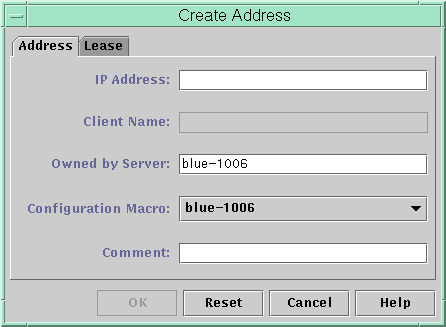
The following figure shows the first dialog of the Add Addresses to Network wizard, used to add a range of IP addresses.
Figure 15-9 Add Addresses to Network Wizard in DHCP Manager
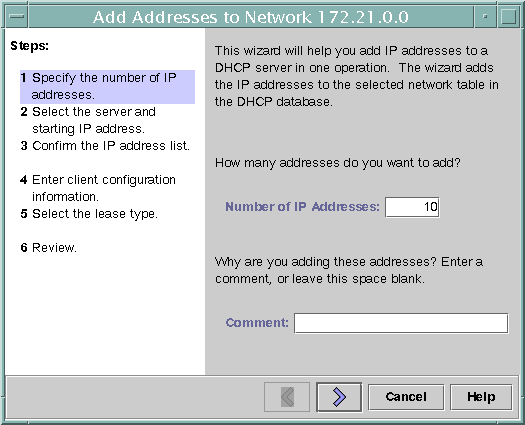
See How to Start and Stop DHCP Manager for information about DHCP Manager.
The Create Address dialog box opens.
Select the Help button to open a web browser to display help for the dialog box. Also, see Table 15-4 for detailed information about the settings.
See How to Start and Stop DHCP Manager for information about DHCP Manager.
You cannot use the same name that is used by the address that you are duplicating.
Most other option values should remain the same.
See How to Start and Stop DHCP Manager for information about DHCP Manager.
The Add Addresses to Network dialog box prompts you to provide values for the IP address properties. See Table 15-4 for more information about the properties, or select the Help button in the dialog box. Making Decisions for IP Address Management (Task Map) includes more extensive information.
The Addresses tab is updated with the new addresses.
For more information about the DHCP Management profile, see Setting Up User Access to DHCP Commands.
Roles contain authorizations and privileged commands. For more information about roles, see Configuring RBAC (Task Map) in System Administration Guide: Security Services.
# pntadm -A ip-address options network-address
Refer to the pntadm(1M) man page for a list of options you can use with pntadm -A. In addition, Table 15-4 shows some sample pntadm commands that specify options.
Note - You can write a script to add multiple addresses with pntadm. See Example 18-1 for an example.
You can modify any of the address properties described in Table 15-4 by using DHCP Manager or the pntadm -M command. See the pntadm(1M) man page for more information about pntadm -M.
The following figure shows the Address Properties dialog box that you use to modify IP address properties.
Figure 15-10 Address Properties Dialog Box in DHCP Manager
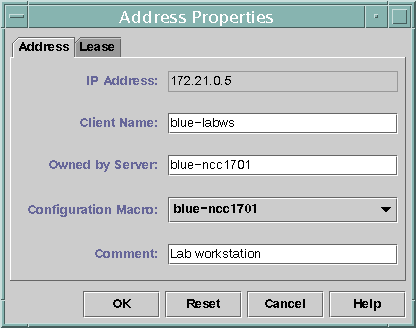
The following figure shows the Modify Multiple Addresses dialog box that you use to modify multiple IP addresses.
Figure 15-11 Modify Multiple Addresses Dialog Box in DHCP Manager
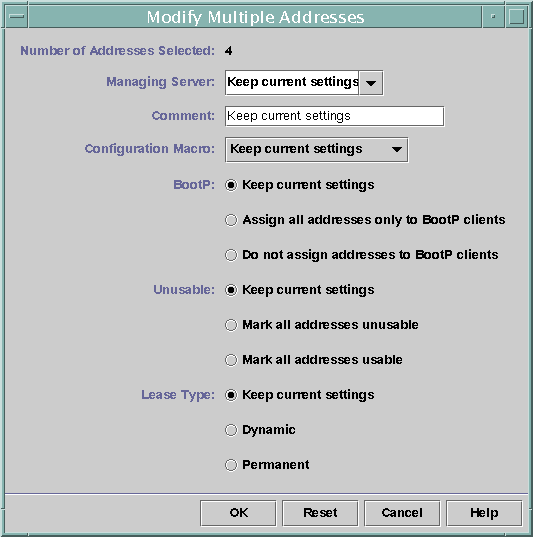
See How to Start and Stop DHCP Manager for information about DHCP Manager.
If you want to modify more than one address, press the Control key while you click with the mouse to select multiple addresses. You can also press the Shift key while you click to select a block of addresses.
The Address Properties dialog box or the Modify Multiple Address dialog box opens.
Click the Help button, or refer to Table 15-4 for information about the properties.
For more information about the DHCP Management profile, see Setting Up User Access to DHCP Commands.
Roles contain authorizations and privileged commands. For more information about roles, see Configuring RBAC (Task Map) in System Administration Guide: Security Services.
# pntadm -M ip-address options network-address
Many options can be used with the pntadm command, which are documented in the pntadm(1M) man page.
Table 15-4 shows some sample pntadm commands that specify options.
At times, you might want the DHCP service to stop managing a particular IP address or group of addresses. The method that you use to remove an address from DHCP depends on whether you want the change to be temporary or permanent.
To temporarily prevent the use of addresses, you can mark the addresses as unusable in the Address Properties dialog box as described in Marking IP Addresses as Unusable by the DHCP Service.
To permanently prevent the use of addresses by DHCP clients, delete the addresses from the DHCP network tables, as described in Deleting IP Addresses From the DHCP Service.
You can use the pntadm -M command with the -f UNUSABLE option to mark addresses as unusable.
In DHCP Manager, you use the Address Properties dialog box, shown in Figure 15-10, to mark individual addresses. You use the Modify Multiple Addresses dialog box, show in Figure 15-11, to mark multiple addresses, as described in the following procedure.
See How to Start and Stop DHCP Manager for information about DHCP Manager.
If you want to mark more than one address as unusable, press the Control key while you click with the mouse to select multiple addresses. You can also press the Shift key while you click to select a block of addresses.
The Address Properties dialog box or the Modify Multiple Address dialog box opens.
If you are editing multiple addresses, select Mark All Addresses Unusable.
For more information about the DHCP Management profile, see Setting Up User Access to DHCP Commands.
Roles contain authorizations and privileged commands. For more information about roles, see Configuring RBAC (Task Map) in System Administration Guide: Security Services.
# pntadm -M ip-address -f UNUSABLE network-address
For example, to mark address 10.64.3.3 as unusable, type:
pntadm -M 10.64.3.3 -f UNUSABLE 10.64.3.0
You should delete IP addresses from the DHCP network tables if you no longer want the address to be managed by DHCP. You can use the pntadm -D command or DHCP Manager's Delete Address dialog box.
The following figure shows the Delete Address dialog box.
Figure 15-12 Delete Address Dialog Box in DHCP Manager
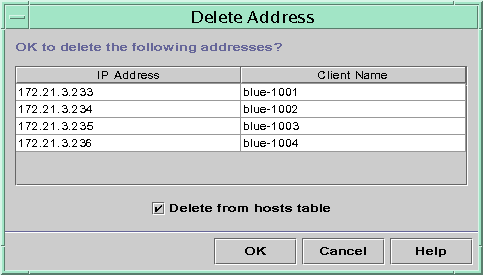
See How to Start and Stop DHCP Manager for information about DHCP Manager.
If you want to delete more than one address, press the Control key while you click with the mouse to select multiple addresses. You can also press the Shift key while you click to select a block of addresses.
The Delete Address dialog box lists the address that you selected so that you can confirm the deletion.
If the host names were generated by DHCP Manager, you might want to delete the names from the hosts table.
For more information about the DHCP Management profile, see Setting Up User Access to DHCP Commands.
Roles contain authorizations and privileged commands. For more information about roles, see Configuring RBAC (Task Map) in System Administration Guide: Security Services.
# pntadm -D ip-address options network-address
If you include the -y option, the host name is deleted from the name service that maintains the host name.
For example, to delete address 10.64.3.3 from network 10.64.3.0, and delete the corresponding host name, type:
pntadm -D 10.64.3.3 -y 10.64.3.0
The DHCP service attempts to provide the same IP address to a client that has previously obtained an address through DHCP. However, sometimes an address has already been reassigned to another client.
Routers, NIS or NIS+ servers, DNS servers, and other hosts that are critical to the network should not be DHCP clients. Hosts that provide services to the network should not rely on the network to obtain their IP addresses. Clients such as print servers or file servers should have consistent IP addresses as well. These clients can receive their network configurations and also be assigned a consistent IP address from the DHCP server.
You can set up the DHCP server to supply the same IP address to a client each time the client requests its configuration. You reserve the IP address for the client by manually assigning the client's ID to the address that you want the client to use. You can set up the reserved address to use either a dynamic lease or a permanent lease. If the client's address uses a dynamic lease, you can easily track the use of the address. A diskless client is an example of a client that should use a reserved address with a dynamic lease. If the client's address uses a permanent lease, you cannot track address use. Once a client obtains a permanent lease, the client does not contact the server again. The client can obtain updated configuration information only by releasing the IP address and restarting the DHCP lease negotiation.
You can use the pntadm -M command or DHCP Manager's Address Properties dialog box to set up lease properties.
The following figure shows the Lease tab of the Address Properties dialog box, which is used to modify the lease.
Figure 15-13 Address Properties Lease Tab in DHCP Manager
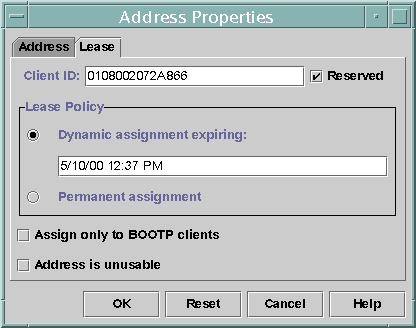
See How to Start and Stop DHCP Manager for information about DHCP Manager.
The Address Properties window opens.
The client ID is derived from the client's hardware address. See the Client ID entry in Table 15-4 for more information.
Select Dynamic if you want the client to negotiate to renew leases, which enables you to track when the address is used. Because you selected Reserved, the address cannot be reclaimed even when a dynamic lease is assigned. You do not need to specify an expiration date for this lease. The DHCP server calculates the expiration date by using the lease time.
If you select Permanent, you cannot track the use of the IP address unless you enable transaction logging.
For more information about the DHCP Management profile, see Setting Up User Access to DHCP Commands.
Roles contain authorizations and privileged commands. For more information about roles, see Configuring RBAC (Task Map) in System Administration Guide: Security Services.
# pntadm -M ip-address -i client-id -f MANUAL+BOOTP network-address
For example, to enable the DHCP client whose MAC address is 08:00:20:94:12:1E to always receive IP address 10.21.5.12, you would type:
pntadm -M 10.21.5.12 -i 0108002094121E -f MANUAL+BOOTP 10.21.0.0
Tip - Refer to the Client ID entry in Table 15-4 for more information about how to determine client identifiers.